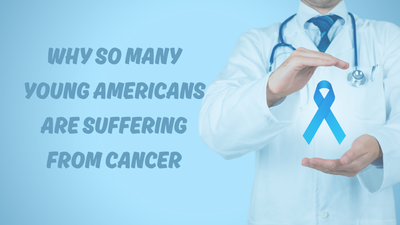ARTICLE AD BOX

Cancer among adults under 50 is rising fastest in America’s agricultural heartland, the Corn Belt, where decades of industrial farming may have left an invisible legacy of illness.
The quick take
Across the Midwest’s corn-producing states — Iowa, Nebraska, Illinois, Minnesota, Indiana and Kansas — cancer rates among young adults aged 15 to 49 are climbing faster than the national average. Once indistinguishable from the rest of the country, the region began to diverge around the early 2000s. Today, Iowa ranks among the top five states for young-adult cancer incidence. According to a recent Washington Post investigation, the data point to a troubling convergence of environmental exposure, delayed diagnosis and a health system still designed for older patients.
What’s happening and where
The Corn Belt has long symbolised American abundance. But as the age of diagnosis falls, the region is turning into a public health puzzle. Young adults in these states are showing notably higher rates of skin, kidney, breast and blood cancers. The pattern is widespread enough to suggest systemic factors rather than isolated clusters. In Iowa’s Madison County, five recent graduates from a single high school were all diagnosed with advanced cancers within two years, a statistical anomaly too large to ignore.
Similar cases are emerging across farm country, where people are now asking whether the land that sustained them is also quietly harming them.
Why the Corn Belt stands out
1. Generations of fertiliser and pesticide use
Industrial-scale agriculture has saturated the soil and water with chemical residues. Herbicides, fungicides and fertilisers have been part of daily life for decades, often handled without adequate protection. Over time, these exposures accumulate, not as dramatic poisonings but as low-level disruptions to DNA, hormones and immunity.
2. Contaminated groundwater
Decades of fertiliser use have left nitrate pollution in aquifers and wells across Iowa and neighbouring states. Nitrates can transform into carcinogenic compounds in the human body. Many rural households depend on private wells, which are rarely tested or treated.
3. Radon gas
Iowa’s soil emits some of the nation’s highest natural levels of radon, a radioactive gas that seeps into homes and is a leading cause of lung cancer.
Testing is inexpensive, but participation remains low.
4. High UV exposure
Farm work means long days in open fields, minimal protection and strong seasonal sunlight. That translates into a sharp rise in skin cancers, particularly among women.
5. Health-care deserts
Many rural hospitals have shut down or scaled back oncology services. Young patients are often misdiagnosed, dismissed as too young for cancer and diagnosed only when the disease is advanced.
The system was built for retirees and is now failing the young.
What the science suggests
Scientists are cautious to assign blame, but they agree on one point: today’s cancers likely reflect yesterday’s exposures. Environmental factors act slowly, interacting with genetics and behaviour across decades. The chemicals used in agriculture may not be singular villains, but together they form a chemical climate, a fog that lingers long after spraying ends. Nitrate, radon and pesticide exposure each carry independent risks, yet their combined effect remains poorly studied. The emerging field of exposomics seeks to measure this lifetime accumulation of environmental harm, offering a more realistic picture than one-chemical-at-a-time testing.
The human cost
Behind the statistics are young people forced into adult illnesses. A 25-year-old waitress in Des Moines discovered her breast cancer after doctors dismissed her lump for months.
A college athlete found a six-inch tumour crushing his lung before graduation. Survivors speak of chemotherapy, infertility, financial ruin and bodies that feel decades older than their age. Cancer care remains tuned to a median patient age of 66. Younger survivors, more likely to live long after treatment, endure years of chronic pain, cardiac strain and reproductive loss. Fertility preservation is often unaffordable.
One survivor said simply, “I’m 29, but I feel 78 inside.”
The policy crossroads
Iowa has launched a state-funded research programme to investigate its rising cancer rates. Lawmakers also blocked a bill that would have protected chemical manufacturers from liability claims, a rare political stand in a region long dependent on agribusiness. Meanwhile, major chemical firms face billion-dollar verdicts in court but continue to defend their products as safe and essential to food security. The Corn Belt is now a testing ground for how America balances industrial productivity with public health. The outcome will shape not only its farms but its future.
What needs to happen next
- Clean the water: Regular nitrate testing for all private wells and stricter limits for public supplies.
- Control radon: Mandatory testing and mitigation subsidies for low-income homes.
- Reform exposure rules: Enforce buffer zones and update farmworker safety protocols.
- Rebuild rural oncology: Telemedicine, mobile clinics and faster referral systems for younger patients.
- Guarantee fertility protection: Mandate insurance coverage for sperm and egg preservation.
- Invest in long-term tracking: Fund studies following children and adults across decades to map cumulative exposure.
The bigger question
For generations, the Corn Belt fed the world. Now it is feeding a reckoning. The region’s rising cancer rates are not only a medical issue but a moral one, a mirror of how societies trade invisible risks for visible prosperity. The land remains golden, the silos full, but the people who work the fields are asking: what did we sow, and what are we harvesting now?

 9 hours ago
3
9 hours ago
3









 English (US) ·
English (US) ·